Spreading Love While Marching for Love While Being Loved

On March 14, in solidarity with children all over the United States, Opal’s students and teachers walked out of school at 10 am, local time. Preparing for the participation of our 3-11 year old students in this event that was recognized widely as both a protest of gun violence in schools and a remembrance of the 17 who died in Parkland, FL on Valentine’s Day was a complicated process. Parents and teachers grappled together with many questions. What is the appropriate role for these young children in this moment? Do they have any role to play? How can we invite them to be in relationship with students across the country in a way that is meaningful to them? How can we invite them to be included in something that has the potential to be so vital to their own health and well-being? How do we keep it appropriate and meaningful?
No adult wanted such very young children to know what had happened in Parkland if they didn’t already. No teacher wanted to talk about it. Parents didn’t want other people’s children to talk about it. While we agreed that it wasn’t necessary or needed for the children to understand or imagine the specific event that lead to the march, we also heard something important from this ordinarily quiet fifth grader:
Petra: Maybe their world of knowledge is small but their world is big and when I was small I could handle it.
She was talking about the youngest children in the school. She was considering what might happen if they knew about the tragedy or the ongoing violence. I believe it is likely that she is right. Children all over the world handle tragic realities as part of their daily lives. The world is big and the children are a part of it. They make themselves a part of it by learning how to live, in any circumstance, from the moment they are born. And so it follows, that the best way to keep their participation appropriate and meaningful, is by listening to them and supporting them to lift their ideas into the world with time, materials, good questions, and invitations to reflect in dialogue with one another.
The following vignettes offer a window into what happened in each classroom — some before as they planned for, and some after as they reflected on the March for Love.
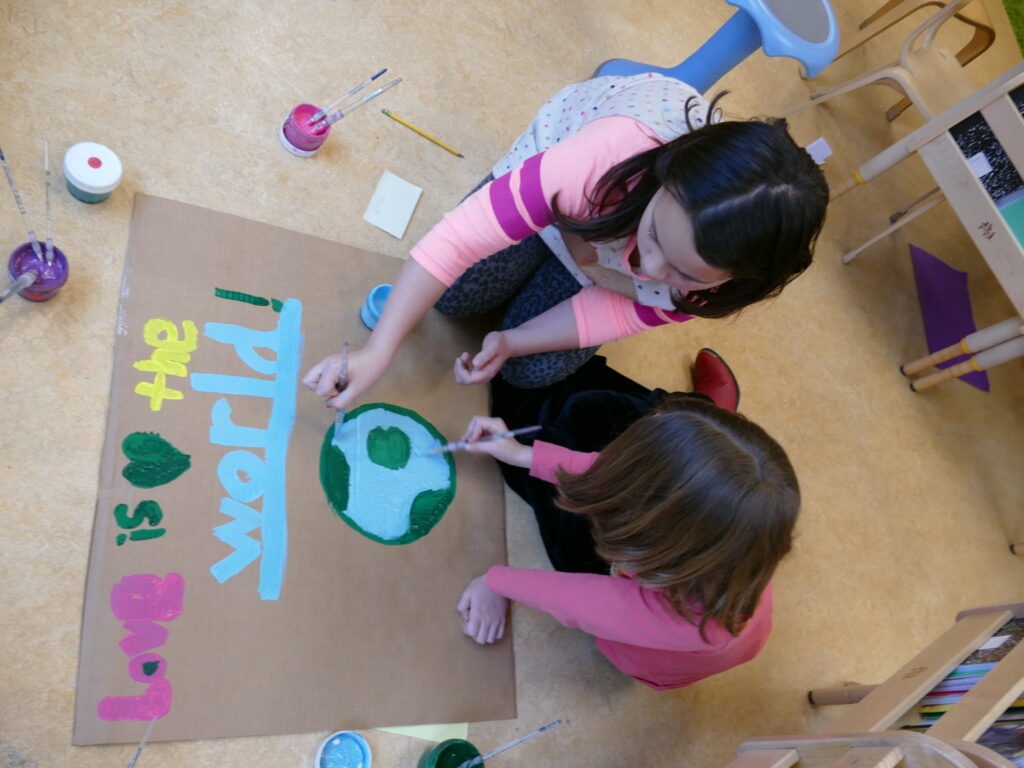
In our Sitka classroom (children ages 8-10), the children prepared for the march:
Sebastian: I’m hoping that once our message in the world people will see that everyone has a right to have love.
Lilly: You need love to be in the world.
Teacher: You know what it feels like to be loved.
Sebastian: And I hope that everyone experiences that.
Louise: I hope we keep on thinking about love and what we need in our community.
Sebastian: Love is like a domino. When you’re kind to someone, that person’s kind to someone else, and someone else and eventually someone’s kind to you because you were kind to one person.
Samantha: We knew we were going to use the word love—love is not only love—there are lots of things inside of it. Helping, kindness–It’s not only one thing.
Tom: Love is like a ripple—a big pool, someone threw a tiny pebble in it and it rippled.
Teacher 2: Kids all across the country that are standing up for love and kindness and community today
The teachers shared images of walkouts happening across the country in earlier time zones.
Lilly: We’re not going to go over there, we’re going to do ours.
Louise: We’re joining them in their work, they’re joining us in our work.
Sebastian: Joining them, we’re also kind of like marching….not taking a plane to Washington DC but we’re joining them in the march —
Louise: Mentally.
Teacher 2: There’s a word for that: Solidarity. We might say we’re “standing in solidarity.”
Seth: I’m guessing it means joining people mentally.
Teacher 2: What does it feel like to see kids all over our country standing up today?
Grant: It’s like strange but joyful…..
Louise: Knowing that other kids care about things and that a lot of people are standing up for what they want….it feels good. The more people doing it, the more people are going to see it.
Lilly: It feels powerful to know they share the same exact thing we’re doing.

Before the march in our Cottonwood classroom (children ages 5-7), children considered what they knew about love:
Grayson: Love is a power.
Allen: Love can create friendship and family
Grayson: Love creates new worlds. It can make you want to work together to create something new for everyone else to have.
The teachers offered the children an invitation to think about this big idea through materials.
Teacher: The invitation is to go to a material and find your thinking about love by exploring the material. You might find an idea that you don’t even know is there. What is going on inside your body, brain, hands, and legs when love comes into you?
Patricia: I need one of those cardboard things over there! I think I need some tape!
Teacher 2:What is your idea?
Patricia: I need this part for what it’s like to feel sorry. Like someone feels sorry and then you feel better. Like this house has hearts on it. It’s nice to decorate someone’s house. And it’s nice inside when someone says sorry.
Estella: I’m thinking of a friendship love that goes fast like a cheetah because it feels good right away.
Flora: It’s a balloon heart that someone let go. Inside me I have a blue heart and then I feel this balloon of love that I like. First it is smaller and then mommy kisses me at night and it gets huge.
Soon, partners were inventing tools for love:
Talulah/Flora: We made a love machine – there’s a love bucket and the person who isn’t feeling happy gets love poured on them and it makes them feel happy.
William/Grayson: We’re making a biplane with a thing on it – a mail biplane. When you put the basket on it, it zips the mail to different classrooms.
Mac/Chuck: We made a feeling detector. It detects love and sadness and all these other feelings and that’s basically what it does so you can know what people are feeling from far distances.
Teacher: Do you think it’s possible that if we share our love in different ways with different people, that it might inspire other people to share love, too?
Samuel: Pretty good. I agree. Because it sounds true!
Trent: Disagree. Because. It just won’t. Some stuff what kindergarteners do, we’re just learning. We don’t know anything. So why bother?
Samuel: I disagree with Trent. I just do.
Grayson: I do, too.
Samuel: I just think that we know things and we know a lot. We don’t know everything. No one knows everything. We don’t know as much as grownups do, but we do know a lot.
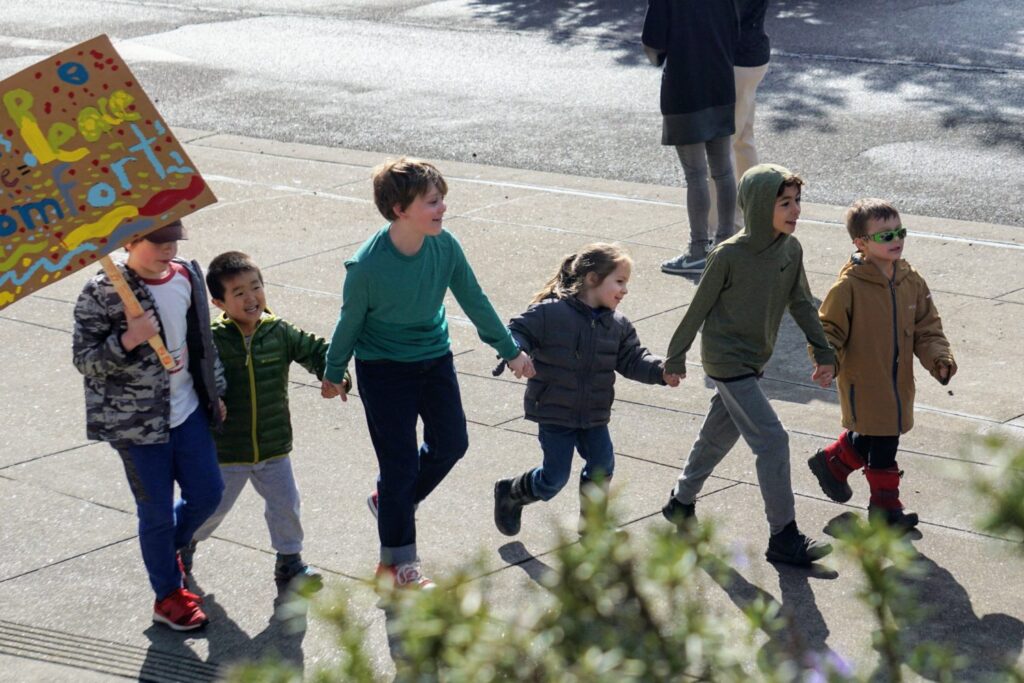
In our Beginning School, after the march, the teachers in Cedar (Children ages 3-5) invited children to share their reflections and memories with some people who hadn’t been there during the march.
Wyatt: Let’s share about the love walk.
Izzy: You get to hang out with your reading buddies. You get to hold up signs, stand up and be proud.
Sarah: When we were walking I loved seeing the signs. They had love stuff on them. Love words.
Wyatt: We also got to speak in a microphone about what you think love means.
Izzy: Love can go to other people. Some will still be in your heart but it will spread too.
Ingrid: One of the things I heard them say is ‘Love is powerful’.
Gretel: I think that means it is magical. The magic in love is it is how people make friends.
Suzy: love is so powerful it can make meanness go away.
Yoli: Love can be powerful because everyone has love and everyone is kind to one another.
Wyatt: Love is also super powerful when everyone nice puts all their love together to defeat bad guys and to make the bad guys nice guys.
Teacher: How does that work? How do the bad guys become nice?
Wyatt: Love does the work because the word love reminds me that love can turn bad guys into good guys. ‘Cause it’s really powerful when everyone who has love puts it together. It makes bad guys into good guys.
And then Belinda offers us a glimpse into the uniquely meaningful way that young children see the world:
Belinda: We saw some butterflies. I saw one and I hugged them.
Teacher 2: I saw a bunch of adults.
Belinda: I saw butterflies.
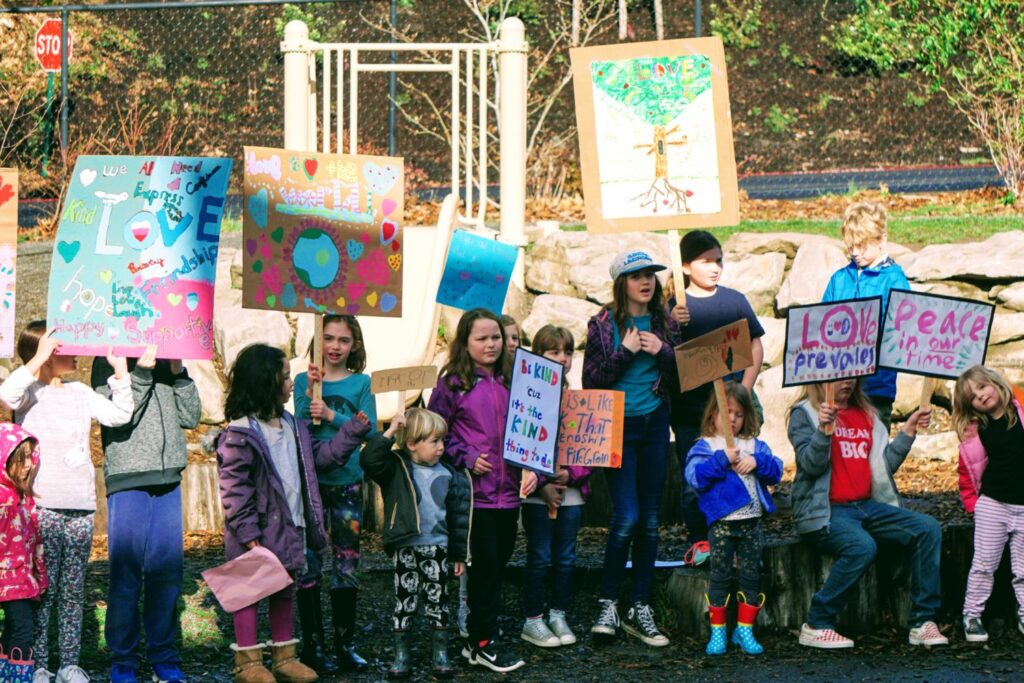
In our Alder classroom (children ages 3-5), it sounded like this:
Teacher: What lives inside this word LOVE?
Ollie: My love is as big as a volcano!
Lulu: My love is bigger than love, it’s kind of like bigger than your heart.
Audrey: My love is happiness to me when I’m sad and mad it helps me feel better.
Rebecca: My love is as big as Mountain Hood!
Eliza: My love is bigger than my heart and my heart is huge.
Edward: We share love always when we are in a community.
Teacher: In what ways?
Edward: In ways like blowing it, like when we are sharing it in different ways we can blow it into hands to give it to them.
Eliza: I gave you all my love and I still have the same that I had before.

In our Dogwood classroom (children ages 6-8), after the march, the children considered what might be next:
Teacher: How do you want the world to receive these messages?
Jake: Mail.
Caleb: Posters.
Alex: Give out papers.
July: Shout them out.
Jake: Put them on the news.
July: Teachers could tell us the conventional way to spell and we could type them up and print them out.
Alex: We could make a newspaper.
Rebecca: We could make signs and hang them up all over downtown because a lot of people go downtown.
Martin: We could make tie-dye shirts.
Elizabeth: I’m adding on to Rebecca’s — we could put them in our neighborhoods because a lot of kids are in my neighborhoods and when they’re going to school they could see those signs and tell their families about them and they could be spread among schools.
Caleb: Yes and, maybe we could, you know those big wooden posts? We could put things up and staple them.
Fred: But nobody really pays attention to them.
July: We could write them on a piece of paper and throw them across neighborhoods and downtown.
Caleb: Maybe you could write it down on a piece of paper and get some duct tape and put them on people’s doors.
Alex: But it also might be rude to tape something on someone’s doors without their permission.
Fred: I feel like we should tape them on to people’s mailboxes.
Adam: I think we should go around and knock on people’s doors and give them the papers.
Maile: Why don’t we just knock on our neighbors’ doors and give them the paper and then go to the next house?
July: Really?! Like a stranger?
Maile: No, just your street. Or you could just leave them a note and put it in their mailbox.
Suzanna: I’m just connecting to my own life, sometimes when my mom is trying to put my baby brother to bed and someone knocks on the door, she gets really angry because it wakes him up and I wonder if there’s a different way…
Suri: If we don’t want to knock, we could put it in their mailbox.
Alex: Yes and we wouldn’t have to knock on the door. We could just stand there and wait.
Suri: Stand there? That might take forever!
Jake: I have a question. Are we going to do this around the world? Or around the neighborhood? Because I feel like, I don’t know if doing the door stuff would take like two years.
Alexandra: I have a question, can all of these ideas relate to the march?
Elizabeth: I remember in the morning, when we were talking about these things, it reminded me of the songs, love one by one, two by two. We could sing them on the march to give our messages.

When Sitka (children 8-10) returned to their classroom after the march, they gathered to reflect.
Teacher: What did you feel when you were marching?
Zed: It felt really good, I wonder how other people celebrated
Teacher: Do you think they shared in some similar feelings?
Zed: Yeah, probably.
Sebastian: To me it felt powerful singing.
Louise: We were spreading love while marching for love while being loved.
Zed: We gave a lot of power to people who have never seen love. Photographers were seeing that, maybe they’ll show their friends.
Kalem: The feeling of love kind of hung in the air.
Louise: I felt a different type of love because my reading buddy didn’t stop hugging me the whole time.
Zed: I felt really happy to be here right now marching for a very important word and all the other words that live inside of it.
Penelope: It was good to be in a space where the love was spreading.
Teacher: What did you notice that the adults were doing? What was the role of the adults?
Zed: They were shocked and proud…they wanted to join us because they thought that this was really important, too, once we started
Ezra: Their role was to support.
Sebastian: They weren’t leading it. We were leading it, they were joining in. If teachers and parents were leading the march—we’re still being controlled. But if we’re leading, we have that freedom.
Louise: (connecting to the all school meeting before the march) What Winslow said—kids should be listened to. Kids get to do their own thing with the grown-ups following along.
Kalem: A lot of adults had cameras—that made me think that their role was to get our ideas out into the world.
Zed: I saw a bunch of people almost crying.
Ezra: Even if they weren’t in Opal they were taking pictures.
Lilly: Why did we do it anyway?….we need love in the world.
Zed: And we need our voices to be heard in the world
Kaine: We did it so that our voices would be heard in the world instead of thinking we’re just kids.
Zed: We know a lot about love and we’re here to show them we know a lot about love and about the world.
Teacher: What is the special power that kids have?
Maude: We have different feelings than adults—adults can do more. Kids have different needs than adults so I think we have different powers because we have different needs.
Teacher: How many of you feel like you have the power to move adults?
Penelope: Adults are so often the ones to plan things, it’s special to see kids leading.
Zed: Especially the really young kids. They were using……they were cute obviously, but also using words that meant a lot to them.
Ezra: Kids leading this big march about a big concept. I would be happy if I was a grown-up to see kids leading this big march!
Zed: Even though there are marches out there with 1000s of people, 135 kids is enough to spread our message.
George: It felt kind of scary for me. It was just something about like—I’m walking to the actual world with actual people watching.
Teacher: Did it feel risky to anyone else?
Louise: It felt risky kind of but when I was walking with my reading buddy and Teddy, the love helped me not feel scared.
Maude: I was happy to stand up for kids’ rights—but it was a little scary, and I was cold.
Teddy: I was cold at first and then I started feeling warm and fuzzy inside.
Pete: Do you know if we’re going to do this again?
Zed: I want to do it again.
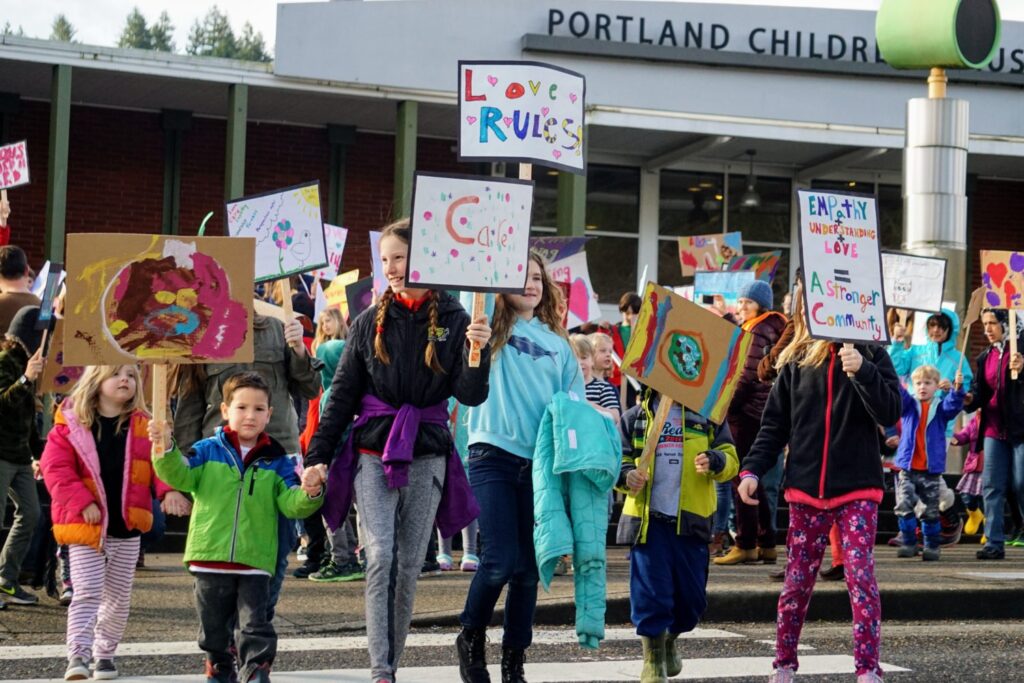
After the march, our oldest students (ages 9-11) in Willow were asked to go around a circle and say a word about how the march made them feel.
Louisa: Included and proud
Winslow: Seen and heard
Maylin: Hopeful that something is going to change
Calla: Hopeful and glad that we had this chance, this opportunity
Leila: Hopeful and I felt caring
Daisy: Mixed emotions
Eleanor: I felt really strong and proud
Jasmine: I felt loved, and since we were walking with our buddies, and even though I don’t have a younger sibling, I felt more protective.
Alex: I felt empowered, I felt strong, and I felt love.
Charles: I felt good to be heard and I felt like I had a stronger voice with the sign.
Harry: I felt … and I was a little worried about being heard and I noticed that most people who weren’t nearby us were like, “don’t look at them”.
David: I felt really interesting because I’ve never done any march before it felt really new.
Isaiah: Strong, bold, famous kinda
Leo: Accomplishment– like we made a change.
Oceana: For me, I felt like we were doing something. There was a feeling with our buddies, like we were really caring for each other and walking. I felt a lot of care around us and that we got our message out and we were working together and showing what we wanted to happen and also marching for it.
Petra: I felt sort of scared
Magnolia: I felt happy and proud that we were doing this… and I felt happy because my buddy was being funny and spinning in circles.
Maya: I felt really happy that we were making a difference and I was wondering how my sign was making a difference. If there was just one it wouldn’t make a difference, but if there were all these it would make a difference.
Claire: I realized there were a lot of people that wanted to do something.
Louisa: I kinda felt like Jasmine, I don’t have a younger sibling, either. I felt like… Opal school is kinda my second home and to have this during my last year — it felt really, really good.
Later they were asked, “What values are reflected in this experience?”
Oceana: Being together and being able to work together and collaborate. It felt like a big project we all worked on together. All the grades were together, marching together– all the signs were different but they were together.
Magnolia: These are things you can’t do alone. Bringing up more ideas and more perspectives than you can do alone creates things that are more powerful.
Louisa: Being able to say what we want to say and believe what we want to believe can make a stronger and better community. We can have different beliefs and perspectives and still have a strong community.
Maylin: It’s better to bring out things we can do to change and make things better than bring out the bad things.
Louisa: You can’t go back in time to change things, you can’t go back in time. You can’t go back. You have to go forward.
Calla: It can make you stronger because you’ve gone through it and you have the tools.
Jasmine: It’s kind of like conflict makes you stronger. If you have a conflict with a friend and you solve it, you’ll remember how you solved it. If you never have a conflict and everything is perfect, when you have a conflict it’s new and your brain might just shut down. If you know how to solve problems then it will make you stronger.
Calla: I’ll add on — if you don’t develop those tools as soon as possible it will be hard to work on bigger problems in the world. If you haven’t developed them on a personal level then it will be harder to take on the problems in the world.
Alex: Adults and older people have more experience than kids because they have been around longer, but kids have a bigger imagination (sometimes) so I just thought about it! It’s kinda the perfect combo, because if parents and kids work together then it’ll be really good.
Oceana: They should know that we have big ideas like adults and that we want to change and that we are able to do stuff. We are able to change stuff.
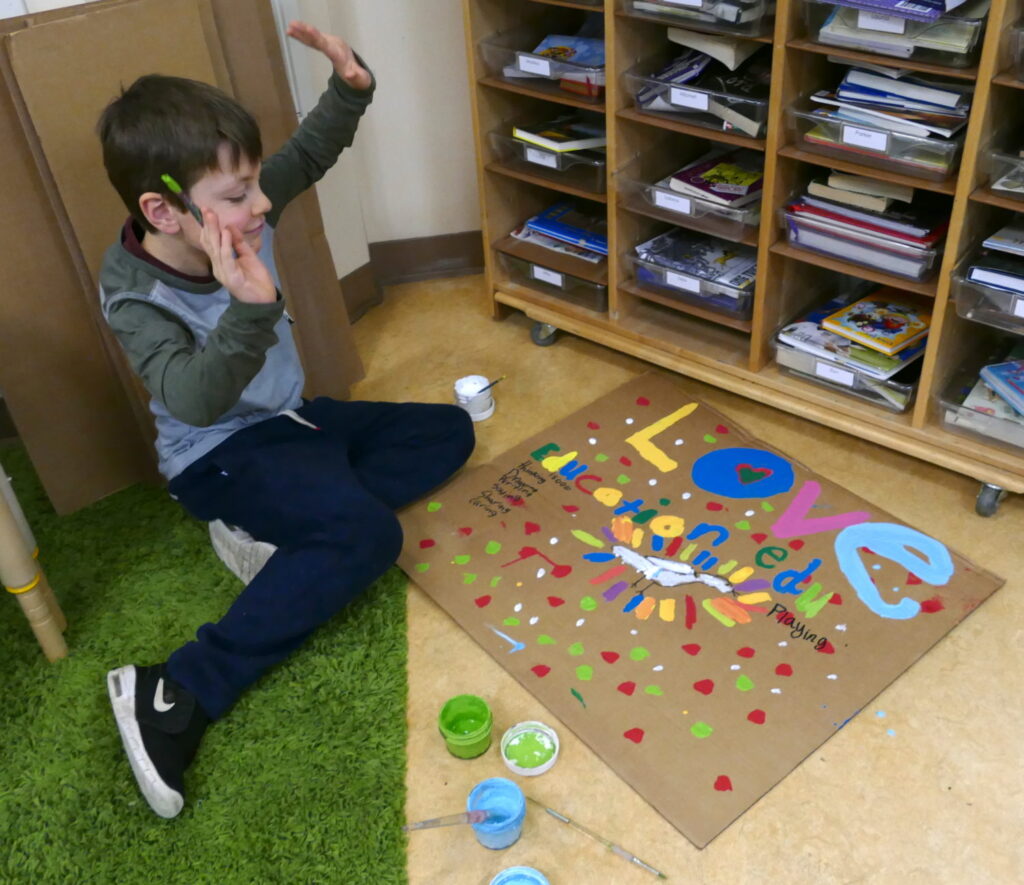
Here is a little more from Sitka’s (children ages 8-10) reflection:
George: I think the center of all things is love.
Louise: Everybody needs love.
Maude: You can believe in whatever you want.
Teddy: You should have people listen to you.
Sebastian: And be heard.
Louise: You have the right to be helped.
Sioban: A right to be cared for, and if you wanted something you need–
Teddy: Say you couldn’t afford power but you needed it, ask for help from neighbors. I think that’s how all countries wanted to start out.
Louise: That’s why people did wars because they didn’t have enough love.
Ezra: Or power.
Zed: You shouldn’t be afraid of showing your love to the world. You gotta take care and be nice to the people who take care and are nice to you.
Louise: Like interpretation, the way that they show appreciation for you is not the way you might show it.
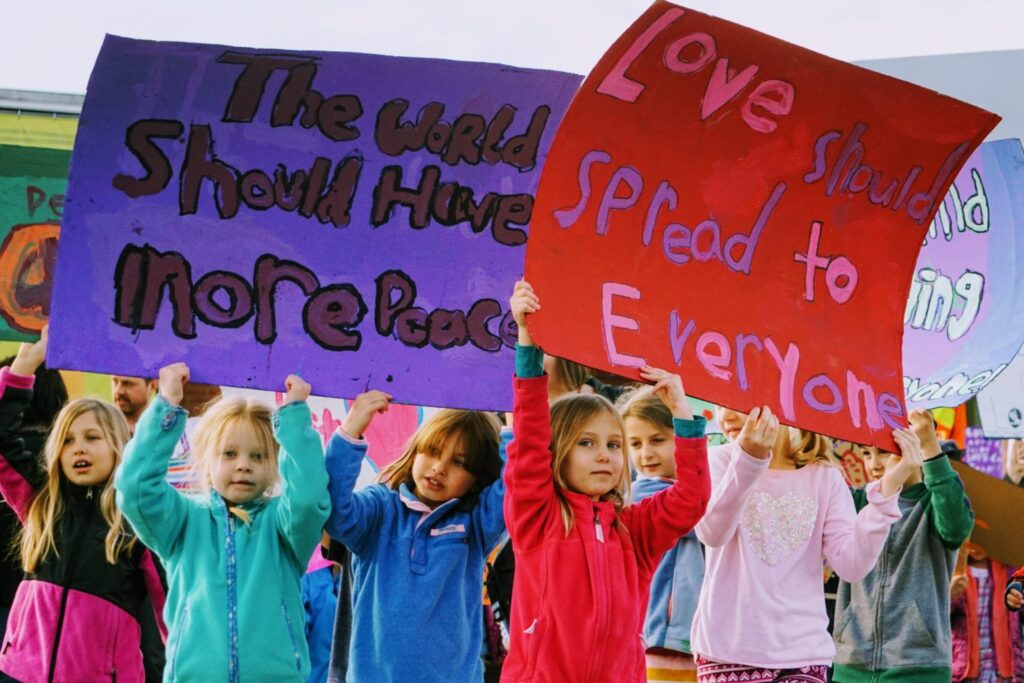
The experiences, as described and considered by all the children, fill us with possibility, inspiration, and hope. Their ideas grow the world that lives inside Dogwood’s (children ages 6-8) simple words:
Children care.
Children are important.
Love is when people share.
Love everyone.
Love should be spread to everyone.
Love can be showed every day.
Indeed it can. How does love show up in your world? How do you spread it around?
After reading reflections from children ages 3-11 about their participation in the National School Walkout, what are your reflections? Has there been a shift in your assumptions about what children “can handle”, as Petra advised? As you read the words of so many young children, what did you think about Trent’s comments that kindergartners “don’t know anything, so why bother?” What are the implications of schooling that works to reinforce that claim versus schooling that tries to dismantle it?
